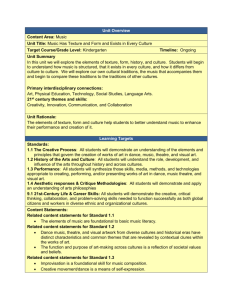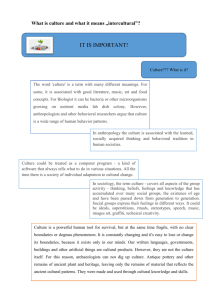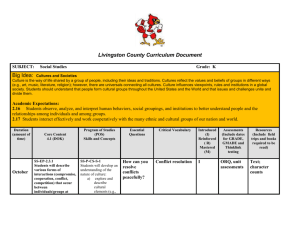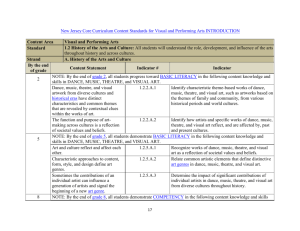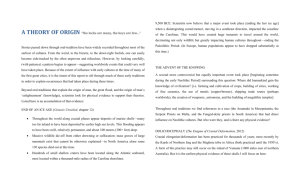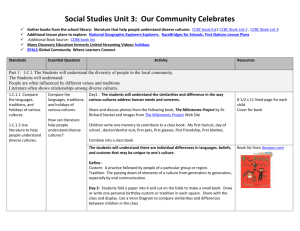Music Has Texture Form and Culture
advertisement
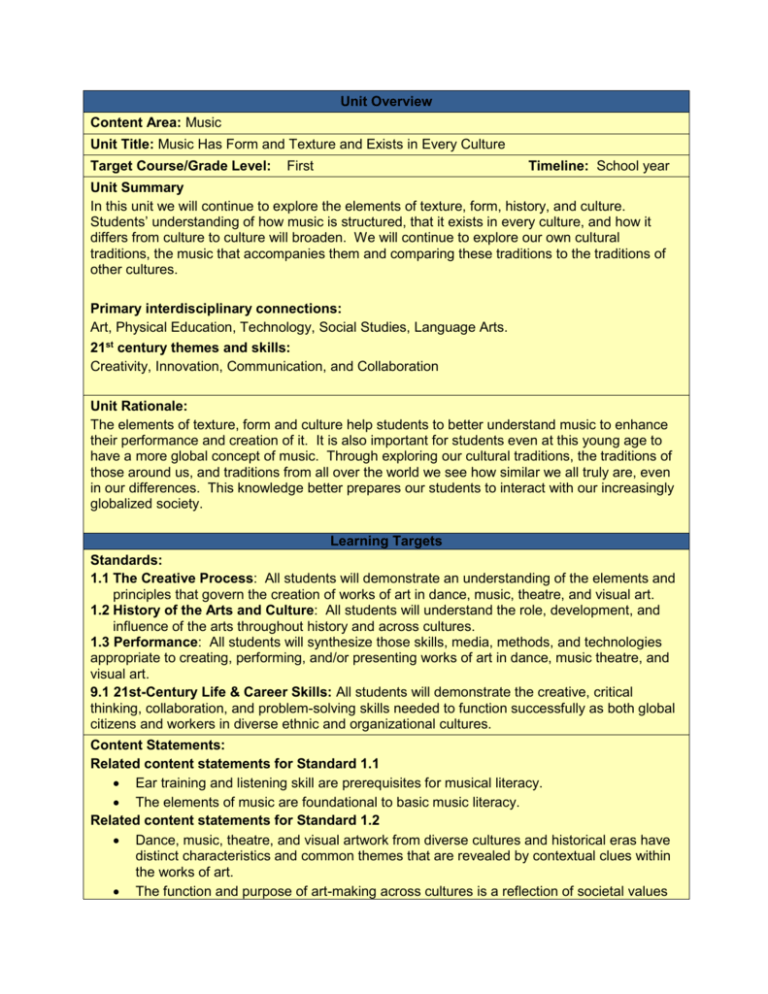
Unit Overview Content Area: Music Unit Title: Music Has Form and Texture and Exists in Every Culture Target Course/Grade Level: First Timeline: School year Unit Summary In this unit we will continue to explore the elements of texture, form, history, and culture. Students’ understanding of how music is structured, that it exists in every culture, and how it differs from culture to culture will broaden. We will continue to explore our own cultural traditions, the music that accompanies them and comparing these traditions to the traditions of other cultures. Primary interdisciplinary connections: Art, Physical Education, Technology, Social Studies, Language Arts. 21st century themes and skills: Creativity, Innovation, Communication, and Collaboration Unit Rationale: The elements of texture, form and culture help students to better understand music to enhance their performance and creation of it. It is also important for students even at this young age to have a more global concept of music. Through exploring our cultural traditions, the traditions of those around us, and traditions from all over the world we see how similar we all truly are, even in our differences. This knowledge better prepares our students to interact with our increasingly globalized society. Learning Targets Standards: 1.1 The Creative Process: All students will demonstrate an understanding of the elements and principles that govern the creation of works of art in dance, music, theatre, and visual art. 1.2 History of the Arts and Culture: All students will understand the role, development, and influence of the arts throughout history and across cultures. 1.3 Performance: All students will synthesize those skills, media, methods, and technologies appropriate to creating, performing, and/or presenting works of art in dance, music theatre, and visual art. 9.1 21st-Century Life & Career Skills: All students will demonstrate the creative, critical thinking, collaboration, and problem-solving skills needed to function successfully as both global citizens and workers in diverse ethnic and organizational cultures. Content Statements: Related content statements for Standard 1.1 Ear training and listening skill are prerequisites for musical literacy. The elements of music are foundational to basic music literacy. Related content statements for Standard 1.2 Dance, music, theatre, and visual artwork from diverse cultures and historical eras have distinct characteristics and common themes that are revealed by contextual clues within the works of art. The function and purpose of art-making across cultures is a reflection of societal values and beliefs. Related content statements for Standard 1.3 Prescribed forms and rules govern music composition, rhythmic accompaniment, and the harmonizing of parts. Basic conducting patterns and gestures provide cues about how and when to execute changes in dynamics, timbre, and timing. Related content statements for Standard 9.1A The ability to recognize a problem and apply critical thinking and problem-solving skills to solve the problem is a lifelong skill that develops over time. Related content statements for Standard 9.1B Brainstorming activities enhance creative and innovative thinking in individual and group goal setting and problem solving. CPI # 1.1.2.B.1 1.1.2.B.2 1.2.2.A.1 1.2.2.A.2 1.3.2.B.6 1.3.2.B.7 9.1.4.A.1 9.1.4.A.5 Cumulative Progress Indicator (CPI) Explore the elements of music through verbal and written responses to diverse aural prompts and printed scores. Identify musical elements in response to diverse aural prompts, such as rhythm, timbre, dynamics, form, and melody. Identify characteristic theme-based works of dance, music, theatre, and visual art, such as artworks based on the themes of family and community, from various historical periods and world cultures. Identify how artists and specific works of dance, music, theatre, and visual art reflect, and are affected by, past and present cultures. Improvise short tonal and rhythmic patterns over ostinatos, and modify melodic or rhythmic patterns using selected notes and/or scales to create expressive ideas. Sing or play simple melodies or rhythmic accompaniments in AB and ABA forms independently and in groups, and sight-read rhythmic and music notation up to and including eighth notes and rests in a major scale. Recognize a problem and brainstorm ways to solve the problem individually or collaboratively. Apply critical thinking and problem-solving skills in classroom and family settings. 9.1.4.B.1 Participate in brainstorming sessions to seek information, ideas, and strategies that foster creative thinking. Unit Essential Questions Unit Enduring Understandings How can we tell the difference Music can have more than one sound at one between melody and harmony? time. What are some differences between Music has specific structure or form. solo singing and choral singing? Music comes from all over the world. What traditions do we celebrate in our culture and how are they alike and different from those of other cultures? Unit Learning Targets Students will ... Identify sections of a song that are alike and different. Understand the difference between a refrain and a verse. Listen to and perform songs in strophic, ABA, and AB form. Sing and dance traditional folk music of different cultures and describe how they are alike and different. Evidence of Learning Summative Assessment Pre-assessment, participation, performance and observation, self and group assessment, question and answer, classroom discussion, and games. Equipment needed: Folksong CD’s, piano or keyboard, rhythm sticks, various hand percussion instruments, poly spots, mallet percussion instruments, various supplemental materials, books, and music. Teacher Instructional Resources: Music Express Subscription Music K-8 Subscription Tempo Magazine Kodaly in the Classroom by Linda Rann Discovering Orff by Jane Franzee Orff-Schulwerk Applications for the Classroom by Brigitte Warner Formative Assessments Self and group assessment and concerts. Integration of Technology: Smart Board Technology Resources: Click the links below to access additional resources used to design this unit: www.classicsforkids.com www.musick8.com www.menc.org www.acda.org www.sfskids.org Opportunities for Differentiation: Differentiate by student need, interest and readiness level. Teacher Notes:
